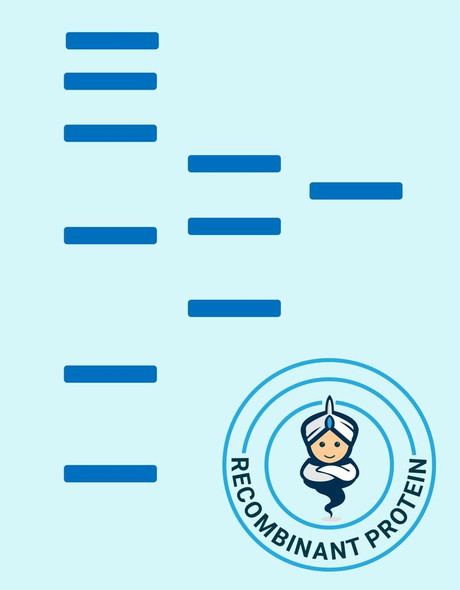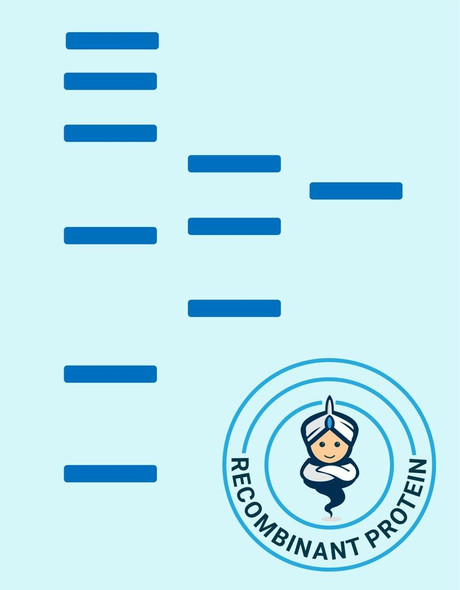Human SDF 1a Recombinant Protein (RPPB1246)
- SKU:
- RPPB1246
- Product type:
- Recombinant Protein
- Size:
- 10ug
- Species:
- Human
- Target:
- SDF 1a
- Synonyms:
- SDF-1
- CXCL12
- Pre-B cell growth-stimulating factor
- PBSF
- Source:
- Escherichia Coli
- Uniprot:
- P48061
Description
| Product Name: | Human SDF 1a Recombinant Protein |
| Product Code: | RPPB1246 |
| Size: | 10µg |
| Species: | Human |
| Target: | SDF 1a |
| Synonyms: | SDF-1, CXCL12, Pre-B cell growth-stimulating factor, PBSF, hIRH, chemokine (C-X-C motif) ligand 12, SDF1, SDF1A, TPAR1, SCYB12, SDF-1a, TLSF-a. |
| Source: | Escherichia Coli |
| Physical Appearance: | Sterile Filtered White lyophilized (freeze-dried) powder. |
| Formulation: | The protein was lyophilized from a concentrated (1 mg/ml) sterile solution containing no additives. |
| Solubility: | It is recommended to reconstitute the lyophilized Stromal Cell-Derived Factor-1a in sterile 18M?-cm H2O not less than 100µg/ml, which can then be further diluted to other aqueous solutions. |
| Stability: | Lyophilized SDF-1a although stable at room temperature for 3 weeks, should be stored desiccated below -18°C. Upon reconstitution CXCL12 should be stored at 4°C between 2-7 days and for future use below -18°C. For long term storage it is recommended to add a carrier protein (0.1% HSA or BSA).Please prevent freeze-thaw cycles. |
| Purity: | Greater than 98.0% as determined by:(a) Analysis by RP-HPLC.(b) Analysis by SDS-PAGE. |
| Amino Acid Sequence: | KPVSLSYRCP CRFFESHVAR ANVKHLKILN TPNCALQIVA RLKNNNRQVC IDPKLKWIQE YLEKALNK |
| Biological Activity: | The specific activity as determined by its ability to chemoattract human peripheral T cells activated with PHA and IL-2 using a concentation of 20-80 ng/ml corresponding to a Specific Activity of 12,500-50,000IU/mg. |
SDF-1 (stromal cell-derived factor-1) is small cytokine belonging to the chemokine family that is officially designated Chemokine (C-X-C motif) ligand 12 (CXCL12). It is produced in two forms, CXCL12a and CXCL12b, by alternate splicing of the same gene. Chemokines are characterized by the presence of four conserved cysteines, which form two disulfide bonds. The CXCL12 proteins belong to the group of CXC chemokines, whose initial pair of cysteines are separated by one intervening amino acid. CXCL12 is strongly chemotactic for lymphocytes and has been implicated as an important cell co-ordinator during development. During embryogenesis it directs the migration of hematopoietic cells from foetal liver to bone marrow. Mice which were knocked-out for CXCL12 gene were lethal before the birth or within just 1 hour of life. As another role, CXCL12a alters also the electrophysiology of neurons. CXCL12 was shown to be expressend in many tissues in mice (including brain, thymus, heart, lung, liver, kidney, spleen and bone marrow).The receptor for this chemokine is CXCR4, which was previously called fusin. This CXCL12-CXCR4 interaction used to be considered exclusive (unlike for other chemokines and their receptors), but recently it was suggested that CXCL12 is also bound by CXCR7 receptor. The gene for CXCL12 is located on human chromosome 10. In human and mouse both CXCL12 and CXCR4 show high identity of sequence: 99% and 90%, respectively.
Stromal Cell-Derived Factor-1 alpha Human Recombinant produced in E.Coli is a non-glycosylated, Polypeptide chain containing 68 amino acids and having a molecular mass of 8004 Dalton. The SDF-1a is purified by proprietary chromatographic techniques.
| UniProt Protein Function: | Function: Chemoattractant active on T-lymphocytes, monocytes, but not neutrophils. Activates the C-X-C chemokine receptor CXCR4 to induce a rapid and transient rise in the level of intracellular calcium ions and chemotaxis. Also binds to another C-X-C chemokine receptor CXCR7, which activates the beta-arrestin pathway and acts as a scavenger receptor for SDF-1. SDF-1-beta(3-72) and SDF-1-alpha(3-67) show a reduced chemotactic activity. Binding to cell surface proteoglycans seems to inhibit formation of SDF-1-alpha(3-67) and thus to preserve activity on local sites. Acts as a positive regulator of monocyte migration and a negative regulator of monocyte adhesion via the LYN kinase. Stimulates migration of monocytes and T-lymphocytes through its receptors, CXCR4 and CXCR7, and decreases monocyte adherence to surfaces coated with ICAM-1, a ligand for beta-2 integrins. SDF1A/CXCR4 signaling axis inhibits beta-2 integrin LFA-1 mediated adhesion of monocytes to ICAM-1 through LYN kinase. Inhibits CXCR4-mediated infection by T-cell line-adapted HIV-1. Plays a protective role after myocardial infarction. Induces down-regulation and internalization of CXCR7 expressed in various cells. Has several critical functions during embryonic development; required for B-cell lymphopoiesis, myelopoiesis in bone marrow and heart ventricular septum formation. Ref.13 Ref.16 Ref.17 Ref.19 Ref.22 Ref.23 |
| UniProt Protein Details: | Subunit structure: Monomer or homodimer; in equilibrium. Dimer formation is induced by non acidic pH and the presence of multivalent anions, and by binding to CXCR4 or heparin. Monomeric form is required for full chemotactic activity and resistance to ischemia/reperfusion injury, whereas the dimeric form acts as a partial agonist of CXCR4, stimulating Ca2+ mobilization but with no chemotactic activity and instead acts as a selective antagonist that blocks chemotaxis induced by the monomeric form. Interacts with the N-terminus of CXCR7. Ref.14 Ref.15 Ref.19 Ref.20 Ref.21 Ref.23 Ref.30 Ref.31 Ref.33 Subcellular location: Secreted. Tissue specificity: Isoform Alpha and isoform Beta are ubiquitously expressed, with highest levels detected in liver, pancreas and spleen. Isoform Gamma is mainly expressed in heart, with weak expression detected in several other tissues. Isoform Delta, isoform Epsilon and isoform Theta have highest expression levels in pancreas, with lower levels detected in heart, kidney, liver and spleen. Ref.2 Developmental stage: Isoform Alpha is ubiquitously expressed in fetal tissues. Isoform Beta and isoform Delta have more limited expression patterns, with highest levels detected in fetal spleen and fetal liver, respectively. Isoform Gamma and isoform Theta are weakly detected in fetal kidney. Ref.2 Post-translational modification: Processed forms SDF-1-beta(3-72) and SDF-1-alpha(3-67) are produced after secretion by proteolytic cleavage of isoforms Beta and Alpha, respectively. The N-terminal processing is probably achieved by DPP4. Isoform Alpha is first cleaved at the C-terminus to yield a SDF-1-alpha(1-67) intermediate before being processed at the N-terminus. The C-terminal processing of isoform Alpha is reduced by binding to heparin and, probably, cell surface proteoglycans. Ref.18 Sequence similarities: Belongs to the intercrine alpha (chemokine CxC) family. Mass spectrometry: Isoform Alpha: Molecular mass is 7959 Da from positions 22 - 89. Determined by ESI. Ref.18Isoform Alpha: Molecular mass is 7606 Da from positions 24 - 88. Determined by ESI. Ref.18Isoform Beta: Molecular mass is 8522 Da from positions 22 - 93. Determined by ESI. Ref.18Isoform Beta: Molecular mass is 8297 Da from positions 24 - 93. Determined by ESI. Ref.18 Sequence caution: The sequence CAC10202.1 differs from that shown. Reason: Erroneous gene model prediction. |
| NCBI Summary: | This gene encodes a stromal cell-derived alpha chemokine member of the intercrine family. The encoded protein functions as the ligand for the G-protein coupled receptor, chemokine (C-X-C motif) receptor 4, and plays a role in many diverse cellular functions, including embryogenesis, immune surveillance, inflammation response, tissue homeostasis, and tumor growth and metastasis. Mutations in this gene are associated with resistance to human immunodeficiency virus type 1 infections. Multiple transcript variants encoding different isoforms have been found for this gene. [provided by RefSeq, May 2013] |
| UniProt Code: | P48061 |
| NCBI GenInfo Identifier: | 1352728 |
| NCBI Gene ID: | 6387 |
| NCBI Accession: | P48061.1 |
| UniProt Secondary Accession: | P48061,Q2L985, Q2L986, Q2L988, Q5IT36, Q6ICW0, Q9H554 B2R4G0, E7EVL0, |
| UniProt Related Accession: | P48061 |
| Molecular Weight: | 10,666 Da |
| NCBI Full Name: | Stromal cell-derived factor 1 |
| NCBI Synonym Full Names: | chemokine (C-X-C motif) ligand 12 |
| NCBI Official Symbol: | CXCL12 |
| NCBI Official Synonym Symbols: | IRH; PBSF; SDF1; TLSF; TPAR1; SCYB12 |
| NCBI Protein Information: | stromal cell-derived factor 1; intercrine reduced in hepatomas; pre-B cell growth-stimulating factor |
| UniProt Protein Name: | Stromal cell-derived factor 1 |
| UniProt Synonym Protein Names: | C-X-C motif chemokine 12; Intercrine reduced in hepatomas; IRH; hIRH; Pre-B cell growth-stimulating factor |
| Protein Family: | Stromal cell-derived factor |
| UniProt Gene Name: | CXCL12 |
| UniProt Entry Name: | SDF1_HUMAN |










